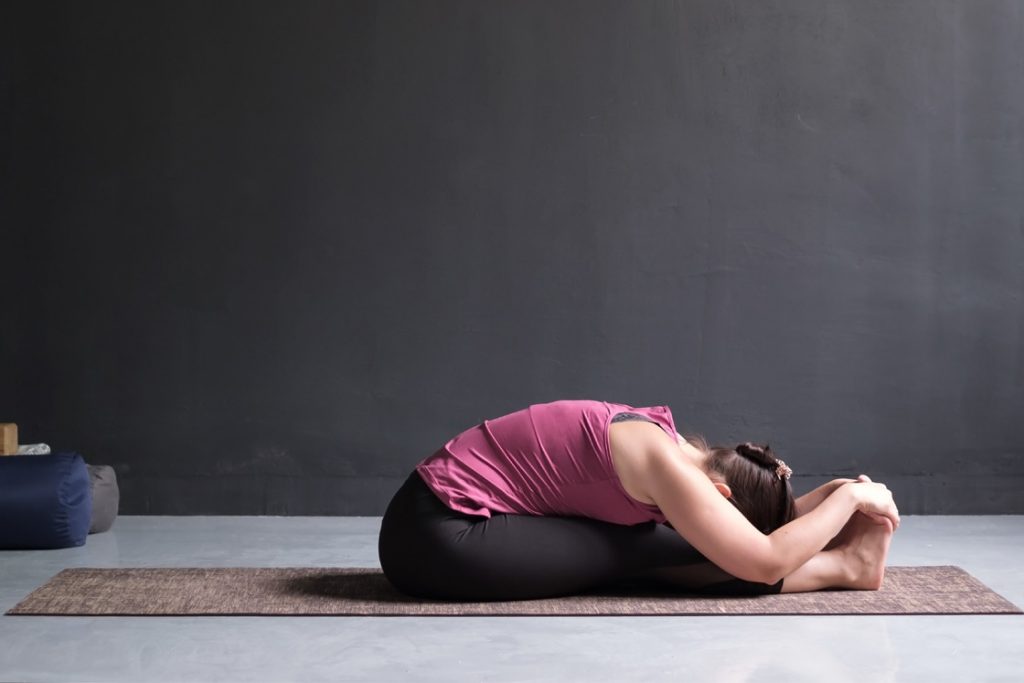
The word “Paschimottanasana” is composed of three Sanskrit words – Paschima refers to the west, but in this context to the back of the body, Uttana means stretching, and asana is the position.
Paschimottanasana is an intense forward bend asana for beginners that stretches the entire back while bending from the waist. It releases the upper body from stress, tension and strain and calms the mind.
This pose is also mentioned in Hatha Yoga Pradipika in Chapter 1 Verse 30:
prasārya pādau bhuvi daṇḍa-rūpau, dorbhyāṃ padāghra-dvitayaṃ ghṝhītvā|
jānūparinyasta-lalāṭa-deśo, vasedidaṃ paśchimatānamāhuḥ ||
which means, “When one has the feet stretched out on the floor like a stick and grasps the toes of both feet with both hands, when one rests the forehead on the thighs, this is called Paśchima Tâna (Paschimottasana).”
This verse introduces us to the pose and also describes the way to perform it.
It can aid in better digestion and stimulates the uterus, ovaries, kidneys, liver, and kidneys. When incorporated into a yoga routine for athletes, the seated forward bend pose can aid in easing tension in the muscles.
Daily mental calming exercises, such as Paschimottanasana, can relieve mild depression and stress, as well as anxiety and exhaustion. They can also promote healthy sleep and reduce anxiety.
Practice Guide for Seated Forward Bend
Preparatory Poses
Head to Knee Pose (Janu Sirasana)
Bound Angle Pose (Baddha Konasana)
Steps to Perform Seated Forward Bend Pose
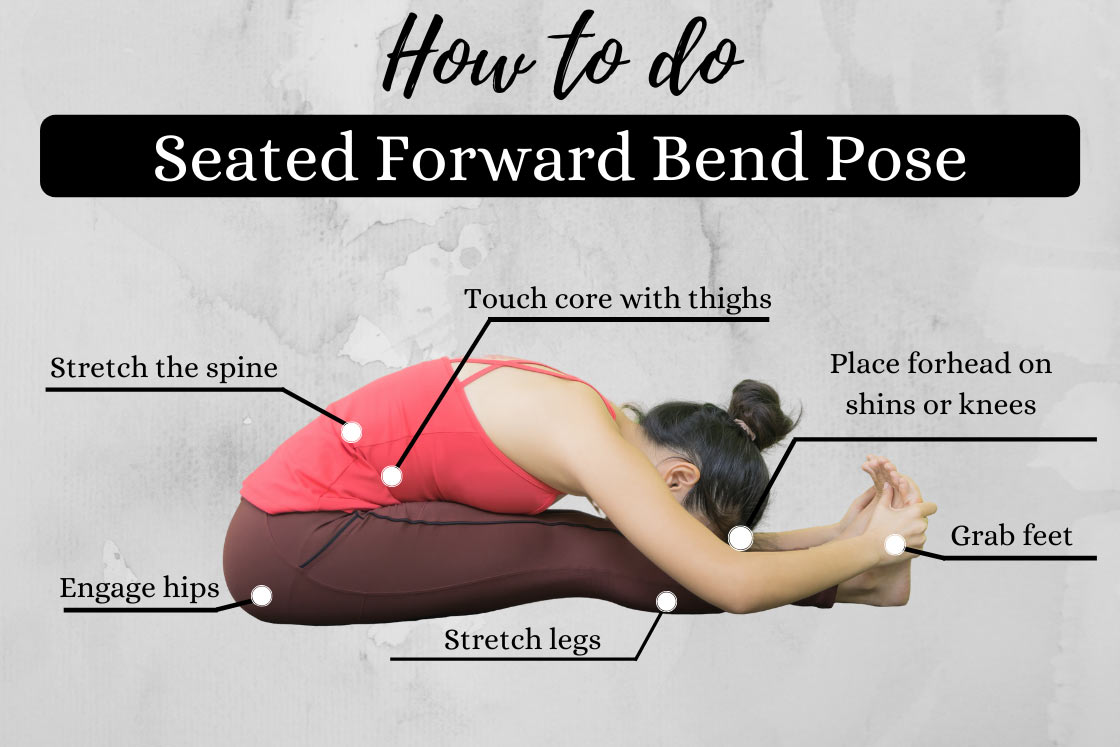
- Adopt an upright posture in Dandasana while flexing your toes in your direction.
- Raise and extend your arms upward as you inhale, focusing on your fingers and crown of your head.
- As you exhale, bend forward, pivoting at the hips. Instead of descending down the knees, keep the spine straight and concentrate on moving forward toward the toes.
- Bend forward untill your abdomen touches your thighs.
- The hand position for this pose has been categorized into three categories – Paschimottanasana A, Paschimottanasana B, and Paschimottanasana C.
- Paschimottanasana A – You hold your big toes of the left and right foot with the first two fingers of your respective hands. You will bend your elbows and rest them on the floor while touching your forehead to the knees.
- Paschimottanasana B – You grab the soles of the feet from the sides and place your forehead on your knees.
- Paschimottanasana C – Your hands wrap around the entire feet and you can grab the right hand’s wrist or palm with the left hand (or vice-versa) and place your forehead on your knees or shins.
- These three categories are in increasing order of difficulty. First, perform Paschimottanasana A. After an increase in hip flexibility and range of motion, go for Paschimottanasana B. Lastly attempt to go for Paschimottanasana C.
- Paschimottanasana A – You hold your big toes of the left and right foot with the first two fingers of your respective hands. You will bend your elbows and rest them on the floor while touching your forehead to the knees.
- Avoid pulling your neck up or entirely letting it go; instead, maintain the spine’s natural extension.
- Hold this position for 3-5 breaths.
- Release your feet and rise. Draw your tailbone into your pelvis as you inhale to raise your torso.
Beginner’s Tips
- Do not force your body to stretch beyond its capacity. Go only as far as your flexibility allows.
- If you are performing this pose for the first time, do not attempt to touch your toes. You can also keep your hands on or above your ankles or anywhere on the shins.
- You can also take the help of your partner or instructor to push your back to increase your stretch.
- Place a folded blanket under your hips to increase comfort.
- Using a yoga strap is highly recommended for beginners or people with stiffness in the hip, back, or shoulder muscles. Bend your knees and loop the strap at the balls of the feet. Hold both ends with your hands and start straightening your legs. As you straighten your legs, bend your upper body as far as you can go.
- If you have tight hamstrings, you can bend your knee to bring them near your chest instead of you folding forward. You can keep a bolster or rolled blanket under the knees to keep them bent comfortably.
- Keeping a bolster lengthwise on your legs will support your upper body and decrease any discomfort.
- As this pose puts pressure on your abdomen, perform this pose 3-4 hours after a meal.
Precautions and Contraindications
- If you are suffering from a slipped disc, spondylitis or hernia, hypertension, or any cardiovascular ailments you should not perform this pose.
- Pregnant women should not perform this asana as this asana puts pressure on the abdomen part and pelvis. It is harmful to the health of the fetus.
- If you have a recent injury or have had surgery on any part of your legs, back, pelvis, and arms do not perform this asana.
Modifications
Seated forward Bend with one leg folded – This variation is more or less the same as the Head to Knee Pose however, the placement of the leg, which is not outstretched, is slightly different. While one leg is extended to the front, the other leg is bent and placed beside the buttocks. Doing this not only opens your hips and groin muscles but also stretches your quads and the IT (Iliotibial) band (connective tissue from the pelvis to the shins).
Follow-up Poses
Wide-Angle Seated Forward Bend (Upavistha Konasana)
Bridge Pose (Setu Bandha Sarvangasana)
Side Bow Pose (Parsva Dhanurasana)
Benefits of Seated Foreward Bend Pose
A seated forward bend works toward lengthening the spine and removing stiffness from the back muscles. This asana stretches your whole body and increases its flexibility. It provides a good shape and posture to the body.
The benefit of Paschimottanasana has been clearly described in Chapter 1 Verse 31 of Hatha Yoga Pradipika :
iti paśchimatānamāsanāghryaṃ, pavanaṃ paśchima-vāhinaṃ karoti |
udayaṃ jaṭharānalasya kuryād, udare kārśyamaroghatāṃ cha puṃsām ||
It means, “this Paśchima Tâna carries the air from the front to the back part of the body. It kindles gastric fire, reduces obesity, and cures all diseases of men”.
Let us see some benefits of this pose:
- Stretches and tones leg muscles, especially hamstrings and calves, providing an excellent shape to the leg.
- Increases flexibility, mobility, and range of motion of the shoulders.
- Increases blood circulation in the spinal columns and aids in spinal decompression.
- Removes stiffness from the back muscles and increases their mobility.
- Massages the abdominal organs such as the pancreas, intestines, liver, kidneys, endocrine glands, etc. and improves their function.
- Promotes a better digestive system and improved metabolism.
- Can remove unnecessary fat and help in weight loss by massaging the abdominal muscles.
- Helps women in menopause and regulates menstruation cycles through the supply of oxygenated blood to the reproductive organs.
- Counters the effects of a hunch back and corrects the posture.
- Aids in alleviating or preventing diabetes, hypertension, menstrual disorders, IBD (Irritable Bowel Syndrome), urinary control disorders, infertility, or impotence.
- Can enhance concentration, memory power, focus, and awareness.
- Alleviates stress, depression, anxiety, anger, and other negative emotions by encouraging blood flow towards the brain.
- Calms the mind and removes restlessness.
Conclusion
The seated forward bend is an extremely beneficial counter pose to backbends. It is also a restorative and rehabilitative pose for individuals who have stiff neck, shoulder, and back muscles. You should include this pose in your routine, preferably towards the end of the yoga session, to give your spine a good stretch.
Frequently Asked Questions
What Muscles Does Seated Forward Bend stretch?
Seated forward bend mostly targets the upper body areas such as your spine, back muscles, neck, shoulders, and chest. And since you are folding from your hips, your hamstrings, buttocks, and knees also get stretched. Your core and abdominal muscles also get a good massage and workout as engaging the will help your keep your spine extended.
Why is Seated Forward Bend so Hard?
Performing a seated forward doesn’t mean that you have to squish your torso to your thighs as rapidly as possible. You are practicing it to lengthen your spine. If you are unable to bend forward, without rounding your spine, chances are you have a stiff lower back and hamstrings.
You should first practice poses that reduce stiffness in these areas. Additionally, using a yoga block under your buttocks and slightly bending and softening your knees to put less pressure on your thighs are some options to make the pose easy.
Is Forward Fold Good for Back Pain?
As long as we regulate the pelvis and spine connection, the forward fold aids in releasing stiffness and tightness in the shoulders while reducing pressure from the back. Relief from lower back and neck strain can alleviate pain or prevent the onset of a strain. The stretching of the back
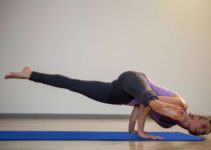
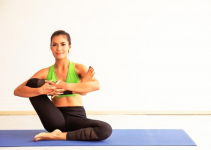
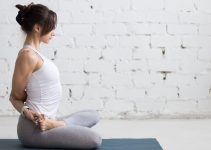


Can Paschimottanasana be practised by Glaucoma patient ? Pl advise